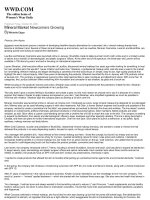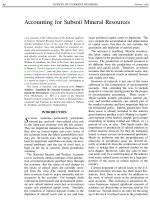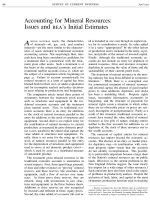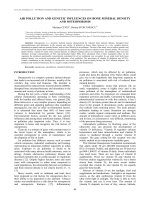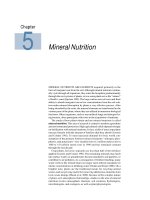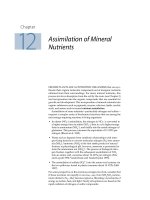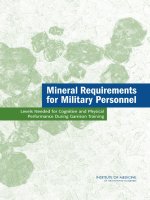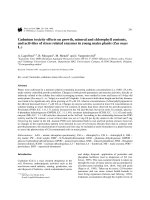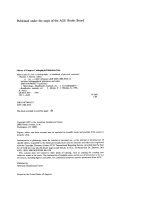mineral resources1
Bạn đang xem bản rút gọn của tài liệu. Xem và tải ngay bản đầy đủ của tài liệu tại đây (1.93 MB, 34 trang )
MINERALS
General Classification of
Nonrenewable Mineral
The U.S. Geological Survey classifies mineral
Resources
resources into four major categories:
Identified:
known location, quantity, and quality or
existence known based on direct evidence and
measurements.
Undiscovered: potential supplies that are assumed to exist.
Reserves: identified resources that can be extracted
profitably.
Other: undiscovered or identified resources not classified
as reserves
General Classification of
Nonrenewable Mineral
Resources
Examples are fossil
fuels (coal, oil),
metallic minerals
(copper, iron), and
nonmetallic minerals
(sand, gravel).
Figure 15-7
GEOLOGIC PROCESSES
Deposits of nonrenewable mineral resources in the
earth’s crust vary in their abundance and
distribution.
A very slow chemical cycle recycles three types of
rock found in the earth’s crust:
Sedimentary
rock (sandstone, limestone).
Metamorphic rock (slate, marble, quartzite).
Igneous rock (granite, pumice, basalt).
Erosion
Transportation
Weathering
Deposition
Igneous
rock Granite,
pumice,
basalt
Sedimentar
y rock
Sandstone,
limestone
Heat,
pressure
Cooling
Heat, pressure,
stress
Magma
(molten rock)
Melting
Metamorphic rock
Slate, marble,
gneiss, quartzite
Fig. 15-8, p. 343
ENVIRONMENTAL EFFECTS OF
USING MINERAL RESOURCES
Minerals are removed through a variety of methods that
vary widely in their costs, safety factors, and levels of
environmental harm.
A variety of methods are used based on mineral depth.
Surface
mining: shallow deposits are removed.
Subsurface mining: deep deposits are removed.
Mining Regulations
The General Mining Act of 1872 is a United States
federal law that authorizes and governs prospecting
and mining for economic minerals, such as gold,
platinum, and silver, on federal public lands. This
law, approved on May 10, 1872, codified the
informal system of acquiring and protecting mining
claims on public land, formed by prospectors in
California and Nevada from the late 1840s through
the 1860s, such as during the California Gold Rush.
Open-pit Mining
Machines dig holes
and remove ores,
sand, gravel, and
stone.
Toxic groundwater
can accumulate at
the bottom.
Figure 15-11
Area Strip Mining
Earth movers strips
away overburden, and
giant shovels
removes mineral
deposit.
Often leaves highly
erodible hills of
rubble called spoil
banks.
Figure 15-12
Contour Strip Mining
Used on hilly or
mountainous terrain.
Unless the land is
restored, a wall of
dirt is left in front of
a highly erodible
bank called a
highwall.
Figure 15-13
Mountaintop Removal
Machinery removes
the tops of mountains
to expose coal.
The resulting waste
rock and dirt are
dumped into the
streams and valleys
below.
Figure 15-14
Environmental Impacts of
Mining
Acid Mine Drainage
Erosion and Sedimentation
Cyanide & Other Toxic Releases
Dust Emissions
Habitat Modification
Surface and Groundwater Contamination
Coal mining affects the
environment
Strip mining causes severe soil erosion and chemical runoff
Acid drainage = sulfide minerals on exposed rock surfaces
react with oxygen and rainwater to produce sulfuric acid
Mountaintop removal causes enormous damage
Coal mining harms human
health
Subsurface mining is harmful to human health
Mine shaft collapses
Inhalation of coal dust can lead to fatal black lung disease
Costs to repair damages of mining are very high
These costs are not included in the market prices of fossil fuels,
which are kept inexpensive by government subsidies
Mining companies must restore landscapes, but the impacts are still
severe
Looser of restrictions in 2002 allowed companies to dump rock and
soil into valleys, regardless of the consequences
Now what do we do with
it?
Once the ore is mined and hauled to the surface, it
must be processed
Tailings
are what is left behind once the valuable
portion of the ore is removed.
Gangue is the commercially worthless minerals
associated with a valuable find.
Mining Impacts
Metal ores are smelted
or treated with
(potentially toxic)
chemicals to extract the
desired metal.
Figure 15-15
Gold Processing
Gold is treated with a Cyanide compound which
produces a Gold-Cyanide complex which is soluble
Problem:
Hydrogen Cyanide gas is toxic
Hyperaccumulation
Hyperaccumulator plants accumulate inordinate
amounts of one or more Trace Elements (TE)s in
their above ground biomass.
Hyperaccumulators
species may accumulate one or
more of a range of TEs that currently includes nickel,
manganese, zinc, cadmium, thallium, copper, cobalt
and arsenic.
Hyperaccumulation may have applications in mining
in the future.
Natural Capital Degradation
Extracting, Processing, and Using Nonrenewable Mineral and Energy Resources
Steps
Environmental effects
Mining
Disturbed land; mining
accidents; health hazards,
mine waste dumping, oil
spills and blowouts; noise;
ugliness; heat
Exploration,
extraction
Processing
Use
Solid wastes; radioactive
material; air, water, and
soil pollution; noise;
safety and health
hazards; ugliness; heat
Transportation or
transmission to
individual user,
eventual use, and
discarding
Noise; ugliness; thermal
water pollution; pollution
of air, water, and soil;
solid and radioactive
wastes; safety and health
hazards; heat
Transportation,
purification,
manufacturing
Fig. 15-10, p. 344
Mining Waste
Subsidence is a phenomenon where the surface
collapses directly above a subsurface mine.
Spoils are the unwanted rock and other waste left
over after mining either on the surface or
subsurface
Tailings are the materials left over after the
process of separating the valuable fraction from the
worthless fraction of an ore.
What to do with the
waste
Incorporate the mine waste into
Concrete
for buildings
Backfill for roads
Extraction of other minerals
ENVIRONMENTAL EFFECTS OF
USING MINERAL RESOURCES
The extraction, processing, and use of mineral
resources has a large environmental impact.
Figure 15-9
SUPPLIES OF MINERAL
RESOURCES
The future supply of a resource depends on its
affordable supply and how rapidly that supply is used.
A rising price for a scarce mineral resource can
increase supplies and encourage more efficient use.
SUPPLIES OF MINERAL
RESOURCES
Depletion curves for a
renewable resource
using three sets of
assumptions.
Dashed
vertical lines
represent times when
80% depletion occurs.
Figure 15-16
